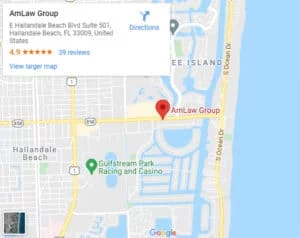How to Apply for an EB-5 Visa in 2025
For many international investors, the EB-5 Immigrant Investor Program represents more than just a financial opportunity. It’s a chance to achieve the American dream. Each year, thousands of families pursue this pathway to secure permanent residency in the U.S. In 2025, the EB-5 Visa process continues to evolve, making it critical for applicants to understand current requirements, investment amounts, timelines, and essential tips to ensure a successful application.
In this guide, we’ll walk you through everything you need to know to apply for an EB-5 visa in 2025 and how long it takes to receive your initial 2-year conditional green card so you can feel confident and informed from start to finish!
Requirements, Investment Options, and Approval Tips
What Is the EB‑5 Visa?
The EB-5 Visa program was established in 1990 by the United States Congress with a dual purpose: to encourage foreign investments that stimulate economic growth and to create jobs for U.S. workers. Today, it stands as a beacon for those seeking a direct route to permanent residency, a coveted Green Card, for themselves, their spouses, and unmarried children under 21.
Unlike other U.S. visa options that often hinge on employment sponsorship or extraordinary professional achievements, the EB-5 program offers a unique opportunity based on capital investment, making it accessible to a broader spectrum of international investors who are ready to contribute financially to the U.S. economy.
Who Typically Applies for an EB-5 Visa?
EB-5 investors come from diverse backgrounds, each with their own unique motivations and goals. They are individuals and families motivated by the dream of stability, security, and opportunity that U.S. permanent residency offers, combined with the willingness and ability to make a substantial investment that benefits the U.S. economy.
Successful EB-5 applicants share a common trait: they’re committed to navigating the EB-5 process and investing thoughtfully in their future!

EB-5 Visa Requirements for 2025
To qualify for the EB-5 visa, investors must meet three specific requirements:
Minimum Investment Amount
The EB-5 program’s investment requirements are structured to incentivize economic growth in areas that need it most. In 2025, the required minimum investment amounts are:
- $800,000 for projects located in Targeted Employment Areas (TEAs).
- $1,050,000 for projects outside of TEAs.
What Is a Targeted Employment Area?
- A rural area (defined as a location outside a metropolitan statistical area or a city/town with fewer than 20,000 people), OR
- An area with unemployment rates of at least 150% of the national average.
By offering a lower investment threshold, the U.S. encourages foreign investors to help revitalize rural communities and high-unemployment regions.
Examples of TEA vs. Non-TEA
TEA Example: A beachfront area in Florida with a high retiree population and low workforce participation.
Non-TEA Example: A luxury apartment complex in Beverly Hills, California.
Even though the investment amount is lower in a TEA, the Green Card benefits are the same. TEA projects are ideal for investors who want to make a meaningful economic impact and meet EB-5 requirements at a more accessible investment level, without compromising on opportunity. Contrary to common belief, TEAs aren’t limited to rural or run-down areas; many qualify due to demographic or employment factors.
Job Creation Requirements
A cornerstone of the EB-5 program is its mandate for job creation. Your EB-5 investment must demonstrably create or preserve at least 10 full-time jobs for U.S. workers within two years of your initial investment.
This job creation element is not merely a formality; it is a central criterion for the approval of your I-829 petition, which seeks to remove the conditions on your permanent residency.
Jobs can be direct (directly employed by your business) or indirect (through an approved regional center).

Demonstrating Lawful Source of Funds
Proving the lawful source of funds for your EB-5 investment is the most critical and often the most scrutinized aspect of your application. USCIS requires meticulous documentation to ensure that your investment funds were obtained legally.
Common sources include:
Gifted Funds: Requires detailed information about the gifter’s origin of funds, gift transaction documentation, and the gifter’s income tax returns for the past seven years.
Earned Salary: Requires a detailed statement of how the investment amount was accumulated, employment verification, and personal income tax returns for the past seven years.
Business Proceeds: Requires proof of original capital source, business activity documentation, and personal and business tax returns.
Real Estate Proceeds: Requires property transaction documents, proof of ownership, tax compliance, and personal tax returns.
Loans: It is possible to use a loan to invest the required amount. Three types of loans can be used for EB-5 investment:
- Company loans
- Loans from friends or family
- Bank loans
This helpful chart is a quick way to review the requirements:

Due to the complex nature of the process, it’s crucial to discuss investment requirements and determine your source of funds with an experienced EB-5 immigration attorney such as AmLaw Group.
Common Misconception about EB-5 Investment Amounts
Many investors mistakenly believe there’s flexibility around EB-5 investment requirements. One common misconception is the belief that the investment amount varies based on whether you choose a direct investment or invest through a regional center.
In reality, the determining factor for the $800,000 or $1,050,000 threshold is the location of the project – whether it is situated within a Targeted Employment Area (TEA) or not.
Get clarity on how the investment amounts are determined by project location from our founder and managing partner, Charles Reaether, in this video:
Choosing Your EB-5 Investment: Direct vs. Regional Center
Choosing between a direct investment and a regional center investment is a pivotal decision. Here’s a closer look at how each option works:
Direct Investment: Hands-on and Entrepreneurial
A direct EB-5 investment allows you to launch or actively manage a U.S. business yourself. Investors pursuing direct investments often choose sectors they’re already familiar with—such as hospitality, retail, or technology startups. Direct investments offer more control but also require more hands-on management, job creation tracking, and oversight.
Regional Center Investments: Passive and Strategic
Investing through a USCIS-approved regional center is the most popular choice due to convenience and reduced complexity. Regional centers handle project selection, management, and reporting.
Investors who prefer passive investments, such as commercial real estate developments, hotels, or infrastructure projects, often choose this option for its simplicity.
Step-by-Step Guide to the EB-5 Visa Application Process
Here’s a breakdown of the EB-5 application journey:
- Initial Consultation and Investment Selection (2-4 months): Consult with an AmLaw Group attorney to evaluate your situation, prepare a road map to document lawful source of funds, and collect and organize all paperwork.
- Fund Selection and Due Diligence (2-4 weeks): Review and select a Regional center project that meets your needs, subscribe to the offering, and complete all background checks before investing in the project.
- I-526 Petition Filing and USCIS Processing (24-36 months, and up to 12 months for rural projects): File Form I-526, Immigrant Petition by Alien Investor, and receive approval from USCIS.
- Visa Interview (Applicants Outside the U.S., 9–12 months after USCIS approval): Attend an interview at a U.S. consulate. Once approved, enter the U.S. within 180 days to activate your green card.
- Adjustment of Status (Applicants Inside the U.S., 6–15 months after USCIS approval): File Form I-485 to adjust status in the U.S. and receive green card within the U.S. without going to the consulate.
- Conditional Green Card (2 years): Upon approval, receive a conditional green card valid for two years.
- I-829 Petition Filing and Processing (2-3 years or longer): File Form I-829, Petition by Investor to Remove Conditions on Permanent Resident Status, to remove the conditions on the green card.
- Permanent Green Card (10-year renewal): After I-829 approval, receive a permanent green card, renewable every 10 years.
- Citizenship: After possessing a green card for five years (including the conditional green card), you can file for citizenship.
Note: Timelines are based on current USCIS trends and may vary depending on your specific situation, investment project, and government processing delays.

Understanding the EB-5 Visa Timeline
Looking for more information about the EB-5 timeline? Our blog post, Unveiling the Investment Green Card Timeline, breaks down each step in more detail!
For visual learners who prefer a dynamic overview of the EB-5 application process, check out our quick video.
Financing Your EB-5 Investment: Can You Use a Loan?
Many investors wonder if they can use a loan for their EB-5 investment. The answer is yes, under specific USCIS guidelines.In fact, some Regional Centers now offer direct loan programs to EB-5 investors, financing a portion of the required $800,000 investment. These loans may continue growing in popularity, as they don’t require investors to prove the source of the loaned funds.
However, if you plan to secure your own loan independently, USCIS requires that the loan must be backed by your personal assets, not the EB-5 project itself. These assets must be lawfully obtained and in your name.
Have questions about using a loan? Our team can help you evaluate your options and stay compliant with USCIS requirements! Schedule a free immigration review here.
How to Increase Your Chances of EB-5 Approval
AmLaw has over 15 years of expertise in EB-5 cases and can help you navigate requirements, avoid common mistakes, and ensure your application is prepared correctly. Beyond working with an experienced legal team, here are a few practical tips to boost your chances of success:
- Documentation Matters: Incomplete or poorly organized documentation can lead to significant delays or even rejection of your application. Ensure all documents are translated (if necessary) and properly certified.
- Understand USCIS Expectations: Staying informed about any updates or changes to the EB-5 program can help you tailor your application to meet the latest requirements.
- Choose a Viable Investment Project: Whether you opt for a direct or regional center investment, conduct thorough due diligence to assess the project’s financial stability, business plan, job creation potential, and the track record of the developers or regional center.
Be Prepared for Scrutiny of Funds: USCIS places a strong emphasis on verifying the lawful source of your investment funds. Be prepared to provide comprehensive and transparent documentation that clearly traces the origin of your capital.
EB-5 Frequently Asked Questions (FAQs)
A: It depends on your investment type and circumstances. In some cases, the process to receive your initial green card can take as little as 12–18 months.
If you invest in a rural project, applications are reviewed on an expedited basis and are often adjudicated within 12 months. For urban projects, review times are typically 2–3 years.
A: Yes! Your spouse and unmarried children under 21 also gain permanent residency.
A: If you are in the U.S. on another valid status (including tourist status), you may apply for Adjustment of Status while filing your EB-5 petition.
This allows you and your family to remain in the U.S, receive work and travel authorization, and travel internationally.
Absolutely. EB-5 investors and their families can choose to live anywhere in the United States, regardless of where the investment was made.
A: Generally, you can apply five years after receiving your conditional green card, provided you’ve spent at least 2.5 years physically present in the U.S. during that time.
Download Your Free Essential EB-5 Handbook
Ready for a deeper dive? Download your FREE EB-5 handbook to take the first step toward a successful EB-5 petition and a future in the United States!
Special Offer: To show our appreciation for downloading the guide, we’re offering an exclusive free personal immigration review to discuss your EB-5 goals and answer any questions you have.

Ready for a Personalized Plan?
Secure Your Future in the U.S. with AmLaw
The EB-5 program isn’t just an opportunity for you—it’s a pathway to a brighter future for your family. From securing visas for your loved ones to enjoying the flexibility and benefits of life after approval, it’s designed to help you achieve your family’s long-term goals.
At AmLaw, we pride ourselves on our 98% approval rate and over 15 years of experience. Contact us today to start your EB-5 immigration journey and make this the year you invest in your future!
Ask A Business Immigration Lawyer

Start your new future in the U.S. now!
Related Posts
L-1 Visa Processing Changes: What It Means for Spouses and Families (2025 Update)
E-2 Visa Renewal: The Essential Guide

Miami Office
AmLaw Group
1920 E Hallandale Beach Blvd Suite 709 Hallandale Beach, FL 33009
Dreaming of Living in the U.S.? Our Business Immigration Attorneys Can Help!
Copyright 2025 AmLaw Group - All Rights Reserved | Powered by Advantage Attorney Marketing & Cloud Solutions




